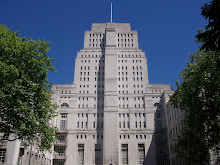
"MI5 Files show how special branch feared uni administrator leaked to USSR
With a shock of unruly hair and an austere stare flashing through her tiny-framed glasses, Dorothy Galton was known at the University of London as a fearsome nit picker of a school secretary.
When she died in 1992, obituary writers could not help but mention her 'formidable' and 'autocratic' approach to the running of the School of Slavonic Studies in Senate House, Bloomsbury.
But files released this week by the National Archives show that MI5 thought she was far more dangerous than a bossy boots who simply berated students for wrongly filled out forms or overdue library books.
Special Branch officers thought Ms Galton was a spy.
The files reveal that for 20 years of her life she was tailed by secret agents who were convinced Ms Galton, who lived for several years in South Hill Park Gardens, Hampstead, was leaking information to Russia at the start of the Cold War.
Between 1932 and '36, she was openly a member of the St Pancras Communist Party, but gave up her subscription to conduct 'special research projects'.
This, the files show, aroused secret services' fears that Ms Galton, who had visited the USSR, had inappropriate access to sensitive information on armed forces personnel who enrolled at the university to quickly learn foreign languages.
Her phones were tapped and her mail was intercepted – although the messages that were discovered had little more information than her joy at riding a mini-motorbike and plans to buy a car and move to a cottage in Essex.
The files, which relate to surveillance carried out throughout the 1930s and 1940s, show how Special Branch officers tried to monitor the rise of Communist debates within the University.
They read 'A powerful personality in the school is the secretary, Dorothy Galton, a most unpleasant and seriously unbalanced woman and the only person in the place which makes a serious attempt at administration. She is by no means efficient, yet through her policy of interfering in every aspect of the school's activities, she exerts considerable influence. Most of the emigre East European students and some of the Americans were met by her with hostility but the Communists find in her a valuable friend.'
The documents, two beefy files of scribbled notes and typed dossiers which have been made available for download on the Public Records Office's website, show how 'discreet enquiries' were ordered to be carried out on the Hampstead neighbourhood where she lived. It was claimed by Special Branch that the NW3 district had many Communist sympathisers.
'We have proved that Miss Galton has access to restricted information', said one secret report. 'The most damning allegation is that the whole of the (School of Slavonic Studies) is unprotected from Miss Galton's 'snooping', or 'from the inquisitive gaze of the Russian intelligence.'
Another report said: 'It would seem wrong that a person of Miss Galton's record should have access to any classified information'.
While they suspected information was being siphoned out of the university's filing cabinets and to eastern Europe, the reports suggest that secret agents failed to find any conclusive proof.
Ms Galton retired from the school in 1961 and went on to keep bees in her retirement and wrote books on bees' wax and honey. She died aged 90 having never married, owned property or used a bank account."
Richard Osley, Camden New Journal 3/9/09




